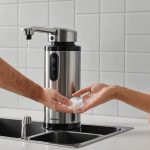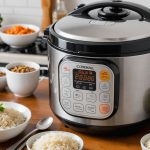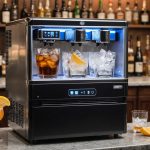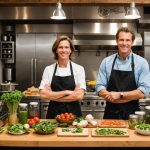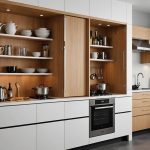Creating an efficient kitchen layout goes beyond aesthetics; it’s essential for food safety. Proper zoning, strategic placement of sinks and prep areas, and thoughtful workflow can significantly reduce the risk of cross-contamination. This guide explores innovative strategies that not only enhance functionality but also prioritize hygiene. By implementing these design principles, you can create a kitchen that fosters safe food preparation and instills confidence in your culinary creations. Explore how to transform your space today!
Understanding Cross-Contamination in the Kitchen
Exploring the risks and solutions for a safer kitchen environment.
Also to read : Top food processor gear and gadgets every kitchen needs
Definition and Significance of Cross-Contamination
Cross-contamination is the transfer of harmful bacteria or substances from one surface to another, often occurring in kitchens. This process compromises food safety, leading to potential health risks. Understanding its significance is crucial, as it directly impacts the quality and safety of the food we consume.
Common Sources of Cross-Contamination in Kitchens
In the kitchen, cross-contamination can arise from several sources. These include unwashed hands, improperly cleaned cutting boards, and using the same utensils for raw and cooked foods. A bulleted list of common sources includes:
Also read : Exploring Creative Retractable Kitchen Cabinet Door Solutions for Space-Saving in Small Areas
- Raw meat and poultry
- Unwashed fruits and vegetables
- Contaminated kitchen surfaces
Each of these can harbor bacteria, making kitchen hygiene a top priority.
Impact of Cross-Contamination on Food Safety
The impact on food safety is significant. Consuming contaminated food can lead to foodborne illnesses, which can be severe and sometimes life-threatening. Maintaining strict kitchen hygiene practices is essential to prevent these occurrences and ensure a healthy cooking environment.
Cross-contamination awareness and proactive measures are vital in safeguarding our health. By understanding these aspects, one can create a safer kitchen and promote better food hygiene practices.
Zoning Strategies for Food Preparation
Creating a seamless workflow in your kitchen.
Importance of Designated Zones for Raw and Cooked Foods
Designating specific kitchen zones for raw and cooked foods is crucial in preventing cross-contamination. This strategy simplifies food preparation and enhances safety by minimizing the risk of harmful bacteria transfer. By clearly separating these areas, you can ensure that raw ingredients, like meat and poultry, do not come into contact with ready-to-eat items.
Best Practices for Organizing Food Prep Areas
Effective organization of food preparation areas involves a thoughtful layout that supports a smooth workflow. Consider arranging your kitchen to include distinct zones for washing, chopping, and cooking. This not only optimizes efficiency but also reinforces hygiene practices.
- Raw Food Zone: Allocate a specific area with dedicated cutting boards and utensils for raw foods.
- Cooking Zone: Ensure this area is separate, with its own set of tools and appliances.
- Cleaning Zone: Position near the sink for easy access to cleaning supplies.
Examples of Effective Zoning Layouts
An efficient kitchen zone layout may resemble a triangle, connecting the fridge, sink, and stove. This classic design promotes a logical flow, reducing unnecessary movement and enhancing productivity. By integrating these zoning strategies, you can transform your kitchen into a safer and more efficient space for all your food preparation needs.
Optimal Placement of Sinks and Appliances
Designing your kitchen for efficiency and safety.
Recommended Locations for Sinks
The sink placement plays a critical role in minimizing contamination. Ideally, sinks should be positioned between the preparation and cooking areas. This allows for easy access to water, facilitating quick cleaning of hands, utensils, and produce. Placing the sink near the prep area ensures that any contaminants from raw foods are washed away promptly, reducing the risk of spreading bacteria.
Positioning of Appliances for Efficient Workflow
Strategically arranging appliances enhances your kitchen's workflow. The stove, fridge, and sink should form a triangle, promoting a seamless cooking process. This layout minimizes unnecessary movement, allowing you to move efficiently between prep and cooking areas. Key appliances like the oven and microwave should be within arm's reach of the cooking zone, ensuring that all necessary tools are easily accessible.
Considerations for Distance Between Prep and Cooking Areas
Maintaining an appropriate distance between prep and cooking areas is essential. This separation prevents cross-contamination and supports a logical workflow. A helpful guideline is to ensure that these zones are distinct yet close enough for convenience.
- Prep Area: Near the fridge and sink
- Cooking Area: Close to the stove and oven
By considering these factors, you create a kitchen that is both safe and efficient.
Recommended Kitchen Layout Styles
Exploring layout options to optimize safety and efficiency.
Advantages and Disadvantages of Common Kitchen Layouts
Different kitchen layout designs offer unique benefits and challenges. The U-shape kitchen provides ample work surfaces and storage, ideal for larger spaces. However, it may feel cramped in smaller kitchens. The L-shape kitchen is versatile, fitting well in both open and enclosed spaces, but might lack storage in compact areas. The galley kitchen, with parallel counters, maximizes efficiency in narrow spaces but can restrict movement if too narrow.
How Different Layouts Influence Cross-Contamination Risks
Layout choices significantly influence cross-contamination risks. In a U-shape kitchen, separate zones can be established for raw and cooked foods, minimizing contamination. The L-shape kitchen allows for clear division of prep and cooking areas, reducing bacteria transfer. In contrast, a galley kitchen may require careful planning to avoid overlap of raw and cooked food zones.
Visual Comparisons of U-Shape, L-Shape, and Galley Kitchens
- U-Shape Kitchen: Ample counter space, ideal for zoning.
- L-Shape Kitchen: Flexible, suits various room sizes.
- Galley Kitchen: Efficient for small spaces but needs careful zoning.
By understanding these kitchen layout designs, you can choose the best option to enhance safety and efficiency in your cooking environment.
Incorporating Hygiene Practices in Design
Designing a kitchen with hygiene in mind ensures a safer and more efficient cooking environment.
Key Hygiene Practices to Implement
Implementing essential kitchen hygiene practices during the design phase can significantly enhance food safety. Consider integrating easy-to-clean surfaces, such as stainless steel or quartz countertops, which resist bacteria and are simple to sanitize. Install touchless faucets to minimize contact and reduce contamination.
- Seamless Surfaces: Avoid grout lines where bacteria can thrive.
- Ventilation Systems: Proper airflow reduces moisture and bacteria growth.
- Dedicated Storage: Separate areas for raw and cooked foods prevent cross-contamination.
Materials and Finishes that Promote Cleanliness
Selecting materials that naturally resist bacteria is crucial for maintaining sanitation. Opt for non-porous surfaces like ceramic tiles or glass splashbacks. These materials are not only durable but also easy to wipe down, ensuring a clean kitchen environment.
Importance of Accessibility for Cleaning and Maintenance
Accessibility is vital for effective kitchen hygiene. Design your kitchen layout to allow easy access to all areas, facilitating thorough cleaning. Position appliances on wheels or with space underneath to reach hidden spots.
By prioritizing these food safety practices, you create a kitchen that supports both cleanliness and efficiency, promoting a healthier cooking space.
Visual Aids and Diagrams for Planning
Utilizing visual tools to enhance your kitchen design process.
Types of Visual Aids Helpful for Kitchen Planning
Incorporating visual aids into your kitchen planning can significantly streamline the design process. Kitchen design diagrams are essential tools, offering a clear visual representation of potential layouts. These diagrams help you visualize space utilization, ensuring efficient and safe design choices. Another useful tool is a layout guide, which provides step-by-step instructions for creating functional kitchen zones.
How to Create Effective Diagrams for Your Kitchen Layout
Creating effective kitchen layout diagrams involves a few key steps. Start by measuring your space accurately, noting the location of existing fixtures. Use graph paper or digital design software to draft your diagram, ensuring all elements are to scale. This approach helps identify the best placement for appliances and work zones, enhancing both efficiency and safety.
Examples of Layout Guides Tailored for Food Safety
To prioritize food safety, consider layout guides that focus on separating zones for raw and cooked foods. These guides often include specific visual planning tools like flowcharts and checklists.
- Flowcharts: Illustrate the movement of food through the kitchen.
- Checklists: Ensure all safety and hygiene practices are considered.
- Zoning Maps: Clearly define areas for different food preparation stages.
By employing these visual planning tools, you can create a kitchen design that prioritizes safety and efficiency.
Tips for Optimizing Workflow
Enhancing your kitchen workflow for safety and efficiency.
Steps to Enhance Workflow While Maintaining Safety
Improving kitchen workflow involves strategic steps that ensure safety and efficiency. Begin by organizing your food preparation zones to minimize movement. Place frequently used items within easy reach to reduce unnecessary steps.
- Declutter Surfaces: Keep countertops clear to streamline tasks.
- Label Storage: Clearly mark containers for quick access.
- Prioritize Safety: Ensure sharp tools are stored securely.
Tools and Gadgets That Improve Kitchen Efficiency
Incorporating the right tools can significantly boost your kitchen's efficiency. Consider gadgets that save time and effort, such as multi-purpose appliances or ergonomic utensils.
- Food Processors: Speed up chopping and mixing tasks.
- Induction Cooktops: Offer faster heating and precise temperature control.
- Magnetic Strips: Keep knives accessible but safely stored.
Layout Adjustments for Various Cooking Styles
Adapting your kitchen layout to suit different cooking styles can further enhance workflow. For instance, if you enjoy baking, allocate a dedicated area with all necessary tools and ingredients.
- Baking Zone: Near the oven, with ample counter space.
- Grilling Area: Close to ventilation for safety.
- Vegetarian Prep: Separate from meat zones to avoid cross-contamination.
By implementing these adjustments, you create a kitchen environment that supports both efficiency and safety.
Additional Resources and Tools
Enhance your kitchen design with these valuable resources.
Recommended Software and Tools for Kitchen Design
Utilizing kitchen design resources can streamline your planning process. Software like SketchUp and Home Designer Suite offer intuitive interfaces for creating detailed layouts. These tools help visualize your space, ensuring efficient use of every inch.
Educational Resources on Food Safety Practices
Understanding food safety is crucial in kitchen planning. The USDA and FDA provide comprehensive guides on safe food handling and storage. These educational resources cover everything from cross-contamination prevention to proper cleaning techniques, empowering you to maintain a hygienic kitchen.
Community Support and Forums for Kitchen Design Advice
Engaging with a community can provide invaluable kitchen design advice. Forums like Houzz and Reddit's r/InteriorDesign offer platforms to share ideas and seek feedback. These communities connect you with experienced designers and fellow enthusiasts, fostering a collaborative environment.
Benefits of Community Support:
- Access to diverse perspectives
- Solutions for unique design challenges
- Ongoing support and motivation
By leveraging these planning tools and resources, you can make informed decisions, ensuring a kitchen that is both safe and functional. Engaging with educational materials and community forums enhances your knowledge, helping you create a space that meets your needs.




